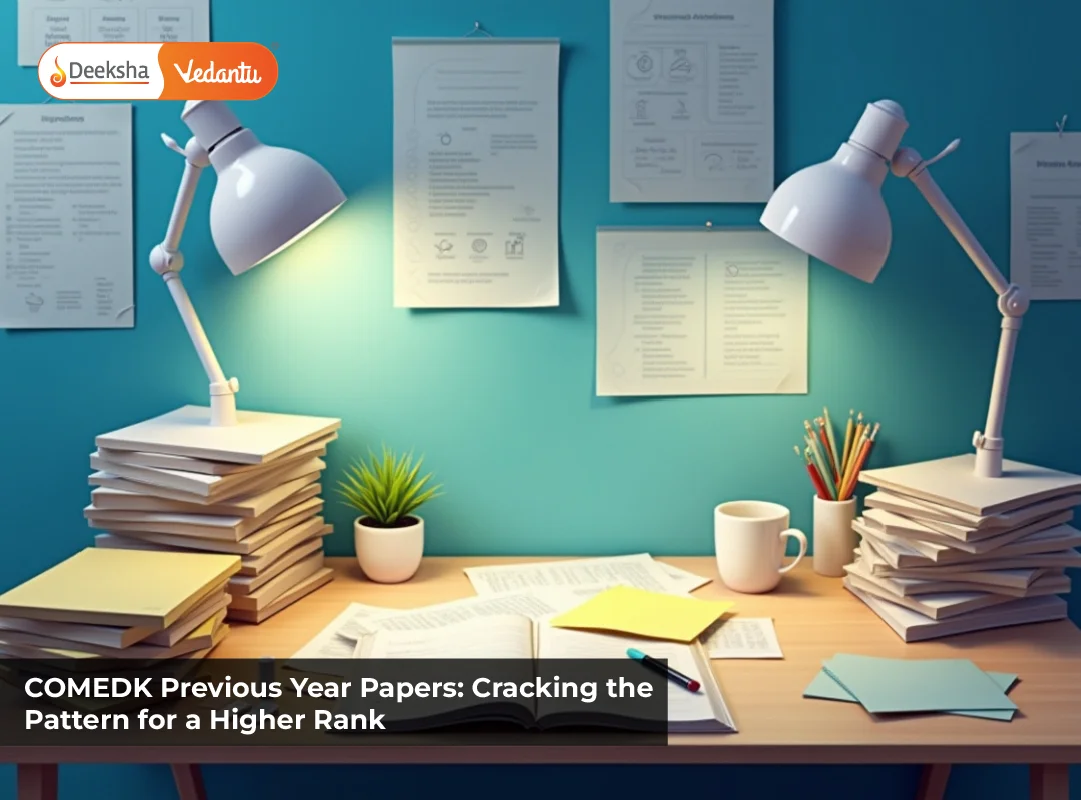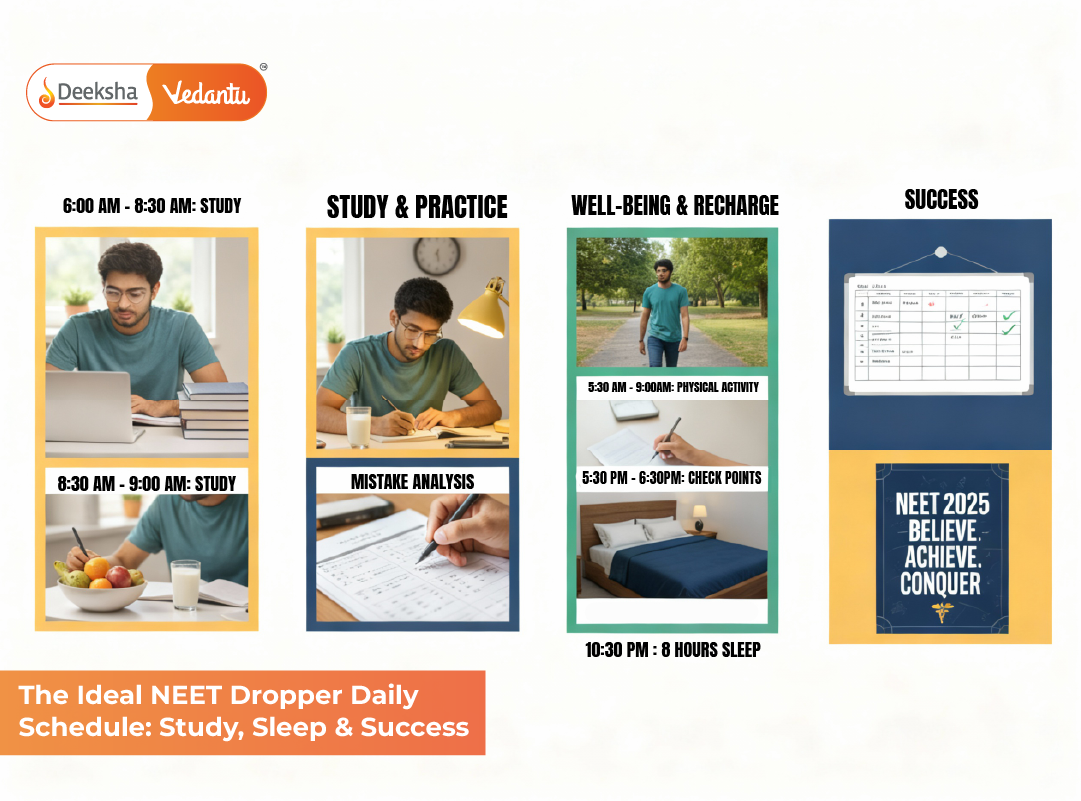Every top scorer in COMEDK has one secret weapon—previous year papers. If you want to crack COMEDK 2025, mastering past paper trends and patterns is non-negotiable. These papers aren’t just for practice; they provide a blueprint of the exam, revealing the most frequently asked topics, difficulty level variations, and scoring opportunities.
Toppers use previous year papers as a predictive tool, analyzing question trends to understand:
- Which topics appear the most?
- What kind of questions are commonly repeated?
- How to manage time efficiently based on past patterns?
Beyond just solving them, students who study past papers strategically can identify high-weightage areas, develop a structured approach to answering, and fine-tune time management skills.
In this blog, we’ll decode the trends from previous year papers, reveal smart solving techniques, and provide a step-by-step approach to making the most of past papers. Whether you’re just starting your COMEDK preparation or refining your final strategy, this guide will help you turn previous year papers into a score-boosting tool.
Why Solving COMEDK Previous Year Papers is a Game-Changer
Decoding the COMEDK Exam Blueprint
Previous year COMEDK papers act as a blueprint for understanding the question weightage, difficulty level, and subject-wise distribution. By analyzing past trends, students can predict which topics demand more focus and where to prioritize their efforts.
What Do Past Papers Reveal?
- Subject-wise weightage: Some topics in Physics, Chemistry, and Mathematics consistently carry more marks than others.
- Recurring concepts: Many questions repeat in similar formats across different years, indicating high-priority topics.
- Theory vs. numericals: Mathematics and Physics often have calculation-heavy questions, whereas Chemistry tends to have more theory-based problems.
- Direct vs. application-based: Some questions are straightforward, while others require conceptual understanding and problem-solving skills.
Students who analyze question trends and focus on high-weightage topics will have a strategic advantage, ensuring their preparation aligns with exam expectations.
How Toppers Use Previous Papers to Their Advantage
Toppers don’t just solve previous year papers—they extract maximum value using a structured approach. Here’s the 5-step strategy that sets them apart:
- Solve in a timed setting – They attempt past papers under real exam conditions to develop speed and accuracy.
- Analyze mistakes thoroughly – Every wrong answer is reviewed, and weak areas are noted for improvement.
- Track question trends – By comparing multiple years, they identify topics that appear most frequently.
- Refine subject-wise strategies – They adjust their study plan based on which subjects or topics take the most time.
- Use past papers for mock tests – Instead of only practicing topic-wise, they take full-length tests to build stamina.
What NOT to Do When Solving Past Papers
- Memorizing answers without understanding concepts.
- Ignoring time limits while solving.
- Skipping answer review and mistake analysis.
Using previous papers the right way can significantly boost exam performance, making preparation smarter, not harder.
Analyzing Question Trends: What Repeats & What’s New?
Subject-Wise Breakdown of COMEDK Question Trends
One of the biggest advantages of solving previous year papers is identifying repeating patterns in COMEDK questions. A detailed subject-wise breakdown helps in prioritizing high-yield topics, ensuring smarter preparation.
| Subject | Recurring Topics | Common Question Types |
| Mathematics | Algebra, Calculus, Coordinate Geometry | Formula-based, conceptual application |
| Physics | Mechanics, Thermodynamics, Electricity & Magnetism | Theoretical + numerical-based |
| Chemistry | Organic reactions, Electrochemistry, Periodic trends | Memory-based, reaction mechanisms |
How Tracking High-Yield Topics Helps
- Reduces effort on low-weightage topics – Focus on areas where questions appear consistently.
- Increases efficiency – Helps in balancing conceptual clarity with problem-solving speed.
- Improves accuracy – Identifying patterns makes it easier to recall formulas and concepts.
Predicting Difficulty Levels Based on Past Papers
- Mathematics tends to have tricky application-based questions.
- Physics includes a mix of direct formula-based and multi-step numerical problems.
- Chemistry has factual, reaction-based, and theoretical questions, making it comparatively scoring.
By analyzing past trends, students can refine their study strategy and allocate preparation time effectively, ensuring a higher score in COMEDK 2025.
The Right Way to Solve COMEDK Previous Year Papers
Full-Length Simulation vs. Chapter-Wise Solving
Students often wonder whether to start with chapter-wise practice or jump straight into full-length past papers. The key is to balance both approaches strategically.
- Chapter-wise practice is best during the initial preparation phase, helping to strengthen concepts before tackling full-length tests.
- Full-length past papers should be attempted in the final months of preparation, simulating the real COMEDK exam for better time management and endurance.
Mimicking real exam conditions by setting up a quiet environment, using a timer, and solving 180 questions in 180 minutes gives an unfair advantage—it builds confidence and helps students learn how to handle exam pressure effectively.
Integrating past papers with mock tests ensures that students get a realistic exam experience, helping them track their progress over time.
Time Management While Solving Past Papers
Effective time management while solving past papers is critical for exam success. Many students waste valuable minutes on difficult questions, leading to unfinished sections.
- Set strict time limits: Allocate 60-70 minutes for Mathematics, 50-60 minutes for Physics, and 40-50 minutes for Chemistry.
- Avoid overthinking: If a question takes more than 90 seconds, mark it for review and move forward.
- Track performance in real-time: Use stopwatches or digital timers to measure time spent on each subject.
- Analyze time-draining questions: Identify which topics consume the most time and refine problem-solving speed accordingly.
By practicing efficient time allocation, students can maximize attempts and improve speed before the actual COMEDK exam.
Common Mistakes to Avoid When Using Past Papers
The “I’ll Solve Papers at the End” Trap
Many students make the mistake of postponing past paper practice until the last few weeks before the exam. This approach limits improvement opportunities and does not allow enough time to analyze mistakes and refine strategies.
The ideal time to start solving past papers is at least 2-3 months before the exam, integrating them alongside regular preparation. Initially, students should focus on chapter-wise past questions, gradually progressing to full-length papers under timed conditions.
Rote Learning vs. Conceptual Understanding
A common mistake students make is memorizing solutions from past papers instead of understanding the logic behind them. Since COMEDK tests conceptual clarity, relying on rote learning will lead to low adaptability when questions are modified.
To tackle this, students should analyze solutions step-by-step, derive answers logically, and practice similar variations of past questions to strengthen problem-solving skills.
Ignoring Answer Review & Analysis
Simply solving past papers without analyzing mistakes defeats the purpose of practice. The real improvement happens in the post-test review, where students can identify weak areas and track recurring errors.
Maintaining a mistake log ensures students do not repeat the same errors and can focus their revision on high-impact improvements.
Final Thoughts on How to Maximize Your Score with Previous Year Papers
Experienced mentors emphasize that previous year papers are more than just practice—they are a roadmap to success. Toppers don’t just solve past papers; they analyze them strategically.
A winning approach involves combining past papers with mock tests, allowing students to identify patterns, track progress, and fine-tune their answering speed. Mock tests simulate real exam pressure, while past papers help in recognizing frequently asked topics.
Successful candidates focus on error analysis and adaptive learning, refining their approach with each test. The key is to learn from mistakes, optimize time management, and improve conceptual clarity.
Using past papers strategically provides a competitive edge. A well-planned approach helps students familiarize themselves with question patterns, improve time management, and boost accuracy.
Instead of solving randomly, students should use past papers to refine their exam strategies, track recurring topics, and build confidence. The right analysis ensures higher efficiency and better performance on exam day.
Level Up Your Preparation with Deeksha’s COMEDK 21-Day Crash Course
For structured guidance and focused preparation, Deeksha’s COMEDK 21-Day Crash Course offers:
- Expert-led coaching tailored specifically for COMEDK 2025 aspirants.
- Mock tests and previous year paper analysis to help you track progress and understand exam trends.
- Personalized study plans and live doubt-solving sessions to strengthen weak areas and improve accuracy.
This crash course is designed to maximize your score in a short time with smart strategies and high-quality mentorship.
👉 Enroll Now in Deeksha’s COMEDK Crash Course and give your preparation the final boost it needs!
Table of Contents










Get Social